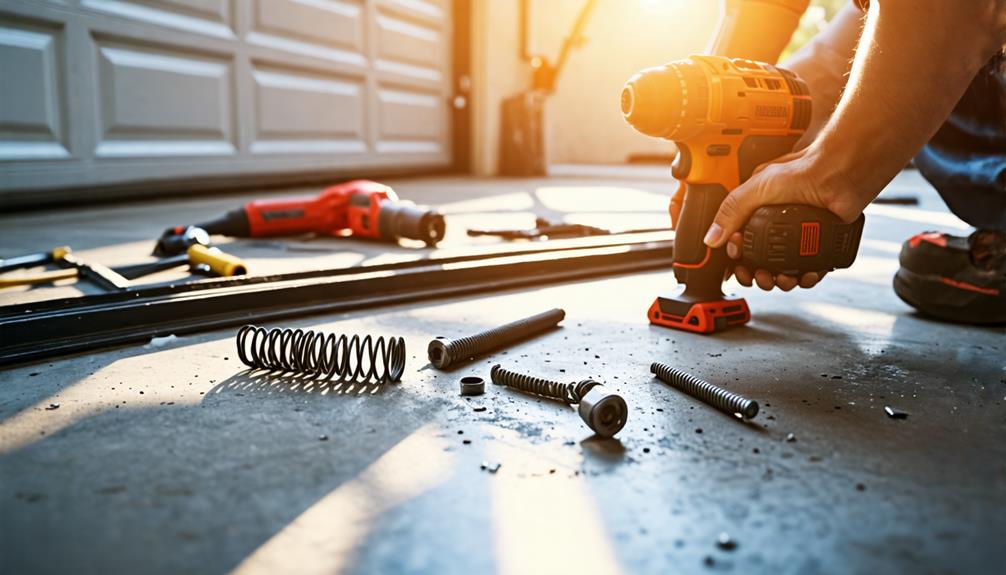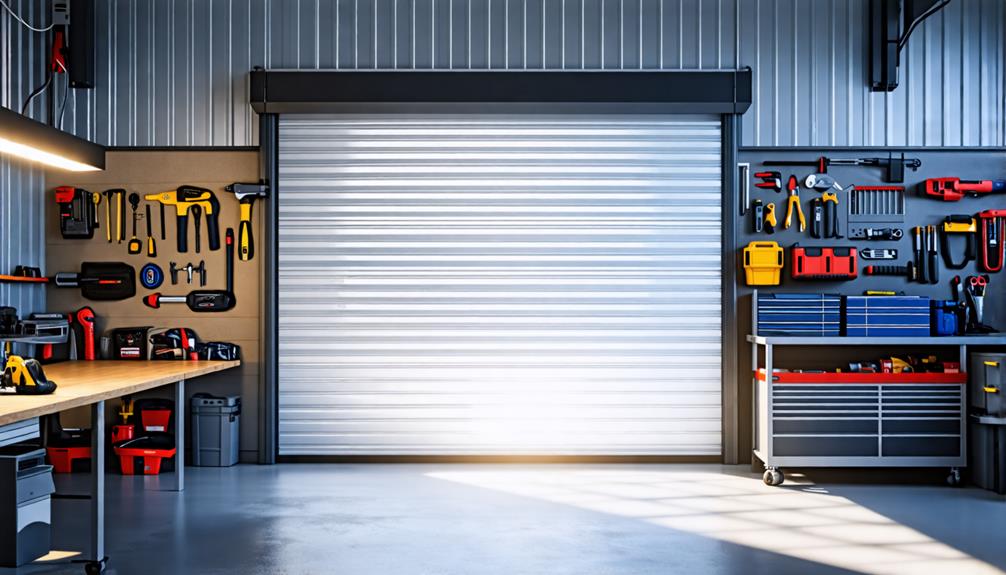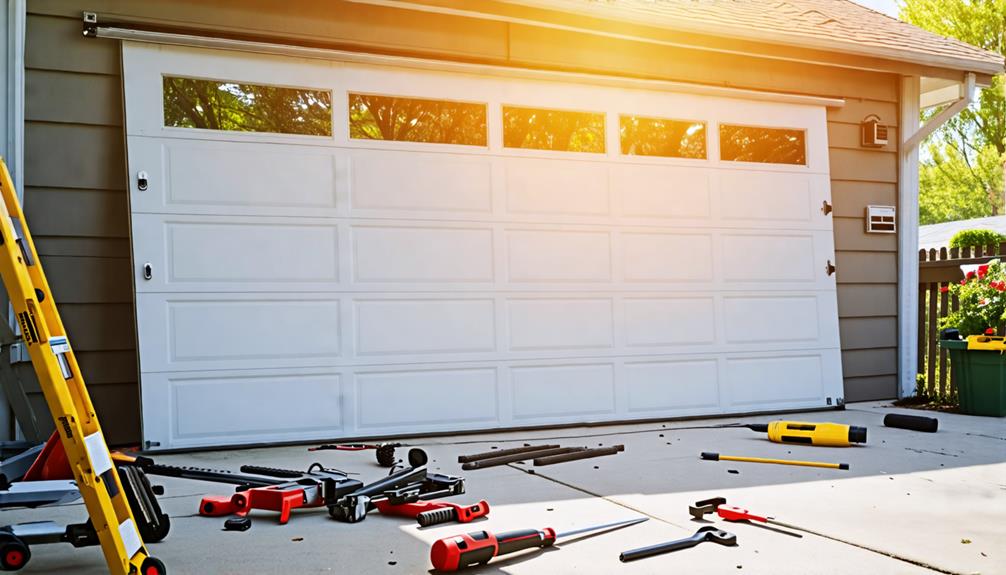
Is It Hard to Replace a Garage Door Yourself?
Replacing a garage door yourself is indeed challenging, requiring significant time, effort, and expertise. You'll need to navigate complex tasks like removing the old door, preparing the opening area, and installing the new door, including intricate components like springs and tracks. DIY installation typically takes 8-12 hours for experienced handymen, and you'll need specialized tools and knowledge of local building codes. While it offers scheduling flexibility and a sense of achievement, the process can be formidable for novices. Professional installation services provide expertise, efficiency, and safety assurances. Consider your skills, available time, and comfort level with such a substantial project before deciding on your approach.
Garage Door Replacement Process

When replacing your garage door, it's essential to first measure the garage opening to guarantee the new door will fit correctly. This is an important step in the garage door installation process.
You'll then need to proceed with the careful removal of the existing door, including its panels, tracks, and hardware, while keeping in mind the necessary safety precautions. Following this, a thorough cleaning and inspection of the opening area is required to address any repairs or modifications needed before progressing with the installation of your new garage door.
Remove Old Door
Many homeowners find removing the old garage door to be the most challenging part of the replacement process. It's vital to approach this task methodically and with caution.
Begin by disconnecting the garage door opener and removing any springs, cables, and tracks. These components can be dangerous if not handled properly, so it's advisable to wear protective gear and work with a partner.
To safely remove the old door panels, follow these steps:
- Unscrew and remove the hinges connecting the panels
- Start with the top panel and work your way down
- Carefully lower each panel to the ground
- Remove any weatherstripping or insulation
- Dispose of the old door panels properly
As you remove the panels, be mindful of their weight and potential for sudden movement. Some doors may have glass inserts or decorative elements that require extra care during removal. If you encounter any resistance or unusual components, consult the manufacturer's guidelines or consider seeking professional assistance.
Prepare Opening Area
With the old door removed, it's time to focus on preparing the opening area for your new garage door. Begin by thoroughly inspecting the frame and surrounding structure for any signs of damage, rot, or wear. Are there any loose boards, cracked concrete, or rusted metal components that need addressing? If so, repair or replace these elements before proceeding.
Next, clean the entire opening area, removing any debris, cobwebs, or old weatherstripping. This step guarantees a clean surface for installation and helps identify any additional issues that may have been hidden. Using a level, check that the header and side jambs are plumb and square. If they're not, you'll need to make adjustments to confirm proper alignment of the new door.
Examine the floor where the door will seal. Is it level? If not, consider adding a threshold or leveling compound to create a smooth, even surface. Finally, measure the opening's width and height at multiple points to verify the new door's dimensions. Are there any obstructions, such as light fixtures or electrical outlets, that might interfere with the new door's operation? Address these issues now to avoid complications during installation.
Install New Door
The heart of garage door replacement lies in installing the new door itself. This process requires attentive consideration to detail and precise execution. You'll need to follow the manufacturer's instructions closely, as each door model may have specific requirements.
Begin by assembling the bottom panel and attaching the hinges. Then, carefully lift and place this panel into the door opening, making sure it's level and centered.
As you progress, you'll need to:
- Install the vertical tracks on both sides
- Attach subsequent panels, connecting them with hinges
- Insert rollers into the hinges and tracks
- Mount the horizontal tracks
- Install the torsion spring system
Remember, safety is paramount during this phase. The torsion spring system is under high tension and can cause serious injury if mishandled. If you're not confident in your ability to install this component, it's wise to seek professional assistance.
Once the door is in place, you'll need to adjust the tracks, springs, and cables to guarantee smooth operation. This fine-tuning process is essential for the door's longevity and performance. Have you considered the importance of proper balance and tension in your new garage door?
Benefits

Replacing your garage door yourself offers several advantages that extend beyond the immediate project. Not only will you experience significant cost savings by avoiding professional installation fees, but you'll also gain firsthand knowledge about garage door operations.
This allows you to better understand the mechanics behind your garage door and can be particularly beneficial for future troubleshooting or maintenance needs. Additionally, you'll have the flexibility to work on your own schedule, allowing you to complete the project at your own pace and experience a profound sense of accomplishment when you've successfully installed your new garage door.
Cost Savings
Financial prudence often drives homeowners to contemplate replacing their garage doors. When you tackle this project yourself, you'll find significant cost savings compared to hiring professionals. The primary expense reduction comes from eliminating labor costs, which can account for a substantial portion of the total replacement cost. Additionally, you'll have the flexibility to shop for materials independently, potentially finding better deals or higher-quality components within your budget.
Consider these potential cost-saving aspects of DIY garage door replacement:
- Avoiding markup on materials
- Eliminating professional installation fees
- Flexibility in scheduling, reducing time off work
- Opportunity to repurpose salvageable parts
- Ability to spread costs over time by purchasing materials gradually
While the initial investment in tools may seem substantial, remember that you'll be able to use these for future projects, amortizing the cost over time. Importantly, by learning the intricacies of garage door systems, you'll be better equipped to perform maintenance and minor repairs in the future, further reducing long-term costs. However, it's imperative to weigh these savings against the potential risks and time investment required for a DIY approach. Are you prepared to invest the necessary time and effort to guarantee a safe, effective installation?
Skill Development
Undertaking a garage door replacement project offers a valuable opportunity for skill development. You'll expand your DIY repertoire by learning to work with various tools, materials, and mechanical systems.
As you navigate the installation process, you'll gain hands-on experience with power tools like drills and impact wrenches, while also honing your measuring and leveling skills. This project will teach you about spring tension, cable systems, and track alignment, which are indispensable components of a properly functioning garage door.
Moreover, you'll develop problem-solving abilities as you encounter and overcome challenges during the installation. How will you adjust for uneven floors? What's the best way to guarantee the door is balanced? These questions will push you to think critically and adapt your approach.
You'll also improve your project management skills, learning to sequence tasks effectively and manage your time. Additionally, this experience may spark an interest in other home improvement projects, potentially leading to further skill acquisition. By completing a garage door replacement yourself, you're not just saving money; you're investing in your personal growth and expanding your capabilities as a homeowner.
Flexibility in Scheduling
Convenience is a major benefit when you choose to replace your garage door yourself. You'll have the flexibility to work on the project at your own pace, without having to accommodate a professional installer's schedule.
This freedom allows you to:
- Plan the installation around your work and family commitments
- Take breaks as needed without feeling rushed
- Work during off-hours or weekends when it's most convenient
- Pause the project if unexpected issues arise
- Complete the installation in stages if time is limited
Sense of Accomplishment
Beyond the practical advantages of scheduling flexibility, replacing your garage door yourself can provide a deep sense of accomplishment. When you tackle this substantial home improvement project, you're not just saving money; you're developing valuable skills and boosting your confidence as a homeowner. The process of researching, planning, and executing such a complex task can be incredibly rewarding, especially when you see the final result of your hard work.
As you navigate the challenges of removing the old door, installing tracks, and hanging the new panels, you'll gain an in-depth understanding of your garage door's mechanics. This knowledge will serve you well in future maintenance and troubleshooting. Additionally, the successful completion of this project may inspire you to take on other DIY home improvements. Have you considered how this experience might empower you to tackle more advanced tasks?
Professional Installation Services Available

Professional garage door installation services offer significant advantages for homeowners looking to replace their existing doors. You'll benefit from the expertise of trained technicians who possess specialized tools and knowledge to guarantee a proper, secure installation. These services not only save you time and effort but also typically come with warranty coverage and insurance protection, providing peace of mind for your investment.
| Service Feature | Benefits |
|---|---|
| Expert Technicians | Precise installation, reduced errors |
| Specialized Equipment | Efficient process, proper alignment |
| Time-Saving | Quick completion, minimal disruption |
| Warranty Coverage | Protection against defects, longer lifespan |
| Insurance Protection | Liability coverage, damage safeguards |
Expertise and Specialized Tools
Installing a garage door requires a significant amount of expertise and specialized tools that most homeowners don't possess. Professional installers have years of experience and training, allowing them to navigate complex installations efficiently and safely. They're equipped with industrial-grade tools designed specifically for garage door installation, ensuring precision and durability.
When you attempt a DIY garage door replacement, you'll likely encounter challenges that professionals are well-prepared to handle. These include:
- Proper spring tension adjustment
- Accurate track alignment
- Correct cable installation
- Precise balance calibration
- Safe removal and disposal of old components
Moreover, professionals understand local building codes and safety regulations, ensuring your new garage door meets all requirements. They can also identify potential issues with your garage's structure or electrical systems that may affect the installation. Have you considered the intricacies of connecting the door to your home's electrical system? Or the complexities of programming modern smart garage door openers? These tasks often require specialized knowledge and tools that aren't readily available to the average homeowner. By hiring professionals, you're not just paying for labor; you're investing in expertise, efficiency, and peace of mind.
Time-Saving Convenience
Time is a precious commodity in our fast-paced world, and opting for professional garage door installation services can save you a significant amount of it. When you choose to have experts handle the job, you'll bypass the lengthy process of researching installation techniques, gathering necessary tools, and troubleshooting potential issues. Professional installers typically complete the task in a fraction of the time it would take a DIY enthusiast, often finishing within a single day.
Have you considered the opportunity cost of spending your weekend on a complex installation? By hiring professionals, you're freeing up valuable time for other priorities or leisure activities. Additionally, installation teams work efficiently, minimizing disruption to your daily routine. They'll handle everything from removing the old door to properly aligning the new one, ensuring smooth operation of the tracks, springs, and opener. You won't need to worry about making multiple trips to the hardware store for forgotten items or dealing with unexpected complications. Instead, you can rely on the installers' expertise to navigate any challenges that arise.
Ultimately, professional installation offers a convenient, stress-free solution that allows you to enjoy your new garage door without the time investment of a DIY approach.
Warranty and Insurance Coverage
With professional installation services, you'll often receive thorough warranty and insurance coverage for your new garage door. This coverage typically includes protection against manufacturing defects, installation errors, and potential damage during the installation process. Professional installers are usually insured, which means you're safeguarded against accidents or injuries that might occur during the installation.
When considering warranty and insurance coverage, it's crucial to understand the following aspects:
- Length of warranty (often ranging from 1 to 5 years)
- Specific components covered (springs, panels, hardware)
- Labor costs for future repairs
- Transferability of warranty to new homeowners
- Exclusions or limitations in coverage
You'll want to carefully review the terms and conditions of any warranty or insurance policy provided. Some companies offer extended warranties for an additional cost, which may be worthwhile if you plan to stay in your home long-term. Remember, DIY installations often void manufacturer warranties, so professional installation can be a smart choice for maintaining extensive coverage. Additionally, your homeowner's insurance may provide some protection for your garage door, but it's vital to verify the specifics with your insurance provider.
Frequently Asked Questions
How Long Does a Typical Garage Door Last Before Needing Replacement?
You can expect your garage door to last 15-30 years, depending on its quality and maintenance. With proper care, you'll extend its lifespan. However, if you're noticing frequent issues, it might be time for a replacement.
Can I Reuse My Existing Garage Door Opener With a New Door?
You can often reuse your existing garage door opener with a new door. However, you'll need to verify it's compatible with the door's weight and size. If it's an older model, you might consider upgrading for better performance and features.
What Are the Signs That Indicate My Garage Door Needs Replacement?
You'll know it's time to replace your garage door if you notice visible damage, rust, or warping. Frequent breakdowns, excessive noise, and increased energy bills are also signs. Consider replacement if your door's over 20 years old or outdated.
Are Smart Garage Doors Worth the Investment for DIY Installation?
Smart garage doors can be worth the investment for DIY installation. You'll enjoy convenient remote access, enhanced security, and energy efficiency. However, consider your technical skills and budget, as they're pricier and may require professional help for complex features.
How Much Weight Can Different Types of Garage Door Springs Support?
You'll find garage door springs vary in their weight capacity. Torsion springs typically support 150-250 pounds, while extension springs handle 40-80 pounds per pair. It's essential to choose the right spring for your door's weight and size.





